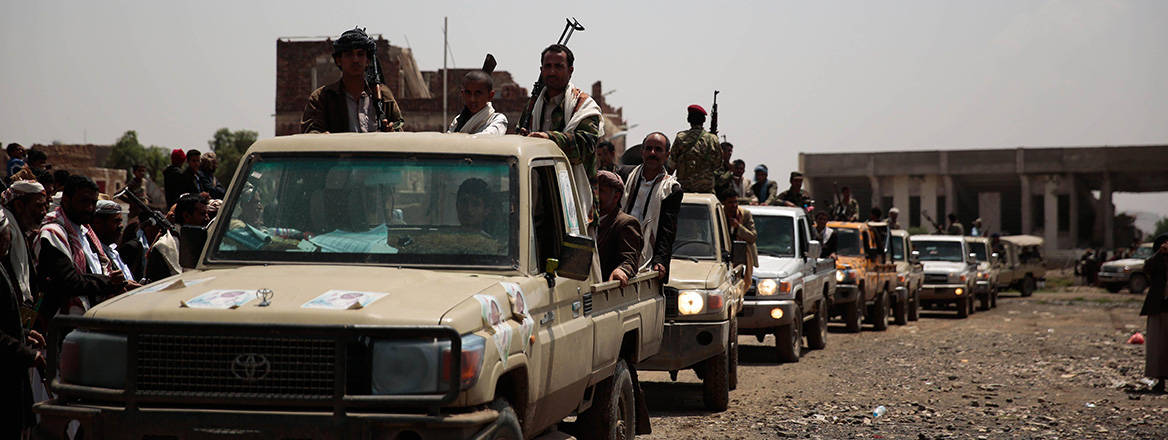Beyond the Axis: Yemen’s Houthis are Building their ‘Network of Resistance’
The Houthis are diversifying their alliances and deepening their military capabilities, leveraging regional conflicts and pragmatic partnerships to expand their influence beyond the Iranian-led ‘axis of resistance’.
Since the 7 October 2023 attacks on Israel, Yemen’s Houthis (who call themselves Ansar Allah) have been further integrated into the Iran-led ‘axis of resistance’. At the same time, the Houthis are building their own ‘network of resistance’, deepening cooperation and cultivating ties with non-state armed actors opposed to the US and Israel, especially in the broader Red Sea region.
Capitalising on the regional standing they have gained due to their attacks against shipping and Israeli territory, the Houthis are working to expand the threat that they pose to navigation. They also aim to diversify their sources and routes for obtaining weapons, as well as partners for smuggling and financing. The Zaydi Shia group’s main purpose is to strengthen its decision-making autonomy and influence vis-à-vis Tehran and its fragmented ‘axis of resistance’: the Houthis have their own genealogy and are allies, not proxies of Iran. Cross-regional alliances complementary to the ‘axis’ can help them to achieve their aspirations, while also enhancing their political leverage in negotiations with Saudi Arabia for a ceasefire in Yemen.
In the Houthis’ political trajectory, adaptability is key. They exploit the context to strengthen their military capabilities, learning from allies. In 2013–14, the Houthis’ alliance of convenience with the Yemeni power bloc still loyal to former President Ali Abdullah Saleh allowed them to gain tribal support, and to receive access to the army’s weapons. Since 2015, the role of Iran’s Islamic Revolutionary Guard Corps (IRGC) and of Lebanon’s Hezbollah has been decisive in transforming the Houthis from local guerrillas into regional actors, providing them with training, advice, missiles, drones and the expertise to assemble weapon components.
The more the Houthis’ regional influence and ambitions rise, the more difficult it will be for regional and international stakeholders to disentangle the war in Yemen from the broader Middle East crisis
After the 7 October attacks, the opening of the Red Sea front has marked the Houthis’ further integration into the Iranian armed constellation, with the role of representatives from the IRGC and Hezbollah in its command-and-control structure (the ‘jihad council’) becoming increasingly crucial. The Houthis also targeted the US Navy and succeeded in downing US drones flying over Yemen. Widely perceived as the only ´achiever` in the axis, the Yemeni group now appears emboldened by its global visibility and by its growing popularity among Arab and Islamic audiences due to its maritime offensive. The Houthis agree with Tehran’s strategic horizon while increasingly cultivating their own 'brand’, supported by an effective propaganda campaign.
Several sources, including the latest report of the UN Panel of Experts on Yemen, highlight the network of allies that the Houthis are shaping directly, without Iran’s intermediation. Relations with Iraqi armed groups have recently entered an upgraded chapter. In May 2024, the Houthis and the Islamic Resistance in Iraq (IRI, a coalition of Shia militias led by Kataeb Hezbollah) announced the coordination of military operations against Israel, jointly claiming responsibility for some unconfirmed attacks against Israeli ports in the Mediterranean. The Houthis opened a political office in Baghdad, while IRI organised fundraising campaigns for them.
Furthermore, the Houthis are now cooperating with armed groups external to the ‘axis of resistance’ and who are Sunnis, not Shia, confirming their extreme pragmatism in alliance-making. For instance, the Houthis and Al-Shabaab, the Somali terrorist group affiliated with Al-Qa’ida, have ‘increased smuggling activities’ involving small arms and light weapons, suggesting a common supplier – namely Iran. This follows reports by US intelligence on talks regarding the delivery of drones by the Houthis to Al-Shabaab.
The Saada-based movement has also shaped an ‘opportunistic alliance’ with Al-Qa’ida in the Arabian Peninsula (AQAP) in Yemen, halting fighting and exchanging prisoners. According to the UN, ‘the two groups [have been coordinating] operations directly with each other’ against the internationally recognised government since early 2024.
Cooperation with Al-Shabaab and AQAP would allow the Houthis to gain access to the Arabian Sea and the Western Indian Ocean, potentially allowing them to expand the threat already posed to maritime security in the Southern Red Sea, the Bab el-Mandeb and the Gulf of Aden. According to the UN, the Houthis are already collecting illegal fees from ‘a few shipping agencies’ to allow their ships to navigate without being attacked, raising about $180 million per month.
Alongside their network of allies, the Houthis are also intensifying contacts with Russia, in this case with Iranian intermediation as the Iran–Russia military partnership consolidates. Delegations met many times in 2024. Russia’s military intelligence personnel are present in Houthi-held areas of Yemen; the Houthis are in talks with Russia for weapons provision, especially anti-ship missiles; and Moscow has shared satellite data about shipping with the group.
The more the Houthis’ regional influence and ambitions rise, the more difficult it will be for regional and international stakeholders to disentangle the war in Yemen from the broader Middle East crisis. Moreover, an emerging Houthi-driven network in the Red Sea region may generate, in the medium to long term, a new destabilising dynamic in an already fragile scenario.
© Eleonora Ardemagni, 2024, published by RUSI with permission of the author
The views expressed in this Commentary are the author’s, and do not represent those of RUSI or any other institution.
For terms of use, see Website Ts&Cs of Use.
Have an idea for a Commentary you’d like to write for us? Send a short pitch to commentaries@rusi.org and we’ll get back to you if it fits into our research interests. Full guidelines for contributors can be found here.
WRITTEN BY
Eleonora Ardemagni
- Jim McLeanMedia Relations Manager+44 (0)7917 373 069JimMc@rusi.org



